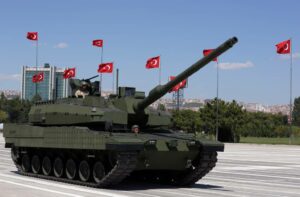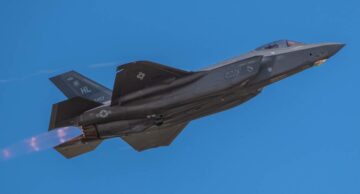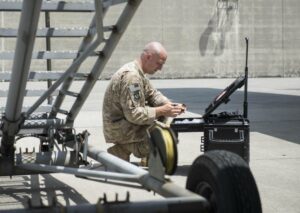
WASHINGTON — In the four years since Congress established the U.S. Space Force, its budget has doubled. That growth needs to continue in order to meet the increasing demand for space capabilities, according to one of the service’s top officials.
Gen. David Thompson, who retires this week from his post as the vice chief of space operations, said that as the Space Force takes on new responsibilities and missions, it needs the resources to match.
“The budget needs to grow because there are still more missions that are migrating to space,” Thompson told C4ISRNET in an interview. “The challenge is, in this environment, defense budgets are likely not to grow significantly in the near future the way they have in the recent past. ”
Congress created the Space Force in December 2019, and a few months later revealed the service’s fiscal 2021 budget request of $15.4 billion. That funding grew to $17.4 billion in fiscal 2022 and then to $24.5 billion in 2023. Its fiscal 2024 request, which is still working through the appropriations process, called for $30 billion.
A significant portion of that funding includes transfers from other military services and consolidating the Space Development Agency under the Space Force. Some represents budget growth for allocated high priority efforts like modernizing the service’s missile warning and tracking satellites, transitioning to large constellations of small satellites and increasing its launch cadence.
In the coming years, the Space Force is poised to play a greater role in some missions that have traditionally been conducted by other services. For example, the Air Force will shift a portion of its ground moving target indicator mission to satellites and the Space Force is exploring the possibility of taking responsibility for tracking moving air targets.
The service’s satellite communication mission is also expanding as space-based internet and inter-satellite links play a greater role in warfare.
“Some of these missions that have been done in a benign environment or in environments where we have air superiority, they have to move to space,” Thompson said. “All of that is mission growth.”
Inflection point
As the Space Force takes on new missions, it is also working to make its existing systems more resilient against threats from adversaries like China. Leaders have set 2027 as a target timeline for fielding key upgrades to the service’s missile tracking satellite constellation, for example.
Thompson also highlighted the Space Development Agency’s space data transport network as another high-priority capability along with GMTI.
“We are not going to be done by 2027,” he said. “But I would say it’s probably an inflection point. In some areas, we’ll be a long way toward that pivot. In some, we’ll be firmly midstream and others we’ll just be starting. Some of that is a function of just laying in the resources and the work to be done.”
He added that how much progress the Space Force makes toward modernizing its architecture in the next few years will be a test of whether the processes and structures it has put into place since 2019 are working as planned.
“We should have a very good assessment at that point as to whether we’re well underway in meeting the challenge or finding struggles in areas that have us relooking at it,” Thompson said. “Today, the leading indicators are all very positive.”
Courtney Albon is C4ISRNET’s space and emerging technology reporter. She has covered the U.S. military since 2012, with a focus on the Air Force and Space Force. She has reported on some of the Defense Department’s most significant acquisition, budget and policy challenges.
- SEO Powered Content & PR Distribution. Get Amplified Today.
- PlatoData.Network Vertical Generative Ai. Empower Yourself. Access Here.
- PlatoAiStream. Web3 Intelligence. Knowledge Amplified. Access Here.
- PlatoESG. Carbon, CleanTech, Energy, Environment, Solar, Waste Management. Access Here.
- PlatoHealth. Biotech and Clinical Trials Intelligence. Access Here.
- Source: https://www.defensenews.com/battlefield-tech/space/2023/12/14/space-force-budget-must-keep-growing-to-support-mission-thompson-says/
- :has
- :is
- :not
- :where
- 10
- 2012
- 2019
- 2021
- 2022
- 2023
- 2024
- 70
- a
- According
- acquisition
- added
- against
- Against Threats
- agency
- AIR
- Air Force
- All
- allocated
- along
- also
- an
- and
- Another
- appropriations
- architecture
- ARE
- areas
- AS
- assessment
- At
- BE
- because
- been
- Billion
- budget
- Budgets
- by
- Cadence
- capabilities
- capability
- challenge
- challenges
- chief
- coming
- Communication
- conducted
- Congress
- consolidating
- continue
- covered
- created
- data
- David
- December
- Defense
- Demand
- Development
- done
- doubled
- efforts
- emerging
- Emerging Technology
- Environment
- environments
- established
- Ether (ETH)
- example
- existing
- expanding
- Exploring
- few
- finding
- firmly
- Fiscal
- Focus
- For
- Force
- four
- from
- function
- funding
- future
- going
- good
- greater
- grew
- Grow
- Growing
- Growth
- Have
- he
- High
- Highlighted
- his
- How
- HTTPS
- i
- images
- in
- includes
- increasing
- Indicator
- Indicators
- Inflection
- Inflection Point
- Internet
- Interview
- into
- IT
- ITS
- jpg
- just
- Keep
- Key
- large
- later
- launch
- laying
- leaders
- leading
- like
- likely
- links
- Long
- MAKES
- Meet
- meeting
- migrating
- Military
- Mission
- missions
- modernizing
- months
- more
- most
- move
- moving
- much
- must
- Near
- needs
- network
- New
- next
- of
- officials
- on
- ONE
- Operations
- or
- order
- Other
- Others
- past
- Pivot
- Place
- planned
- plato
- Plato Data Intelligence
- PlatoData
- Play
- Point
- poised
- policy
- portion
- positive
- possibility
- Post
- priority
- probably
- process
- processes
- Progress
- put
- recent
- Reported
- reporter
- represents
- request
- resilient
- Resources
- responsibilities
- responsibility
- Revealed
- Role
- s
- Said
- satellite
- satellite constellation
- satellites
- say
- says
- Services
- set
- she
- shift
- should
- significant
- significantly
- since
- small
- some
- Space
- Space Force
- space-based
- Starting
- Still
- structures
- Struggles
- support
- Systems
- takes
- taking
- Target
- targets
- Technology
- test
- that
- The
- then
- There.
- These
- they
- this
- this week
- thompson
- threats
- Through
- timeline
- to
- told
- top
- toward
- Tracking
- traditionally
- transfers
- transitioning
- transport
- u.s.
- U.S. Space Force
- under
- Underway
- upgrades
- us
- very
- vice
- warning
- Way..
- we
- week
- WELL
- whether
- which
- WHO
- will
- with
- Work
- working
- would
- years
- zephyrnet












